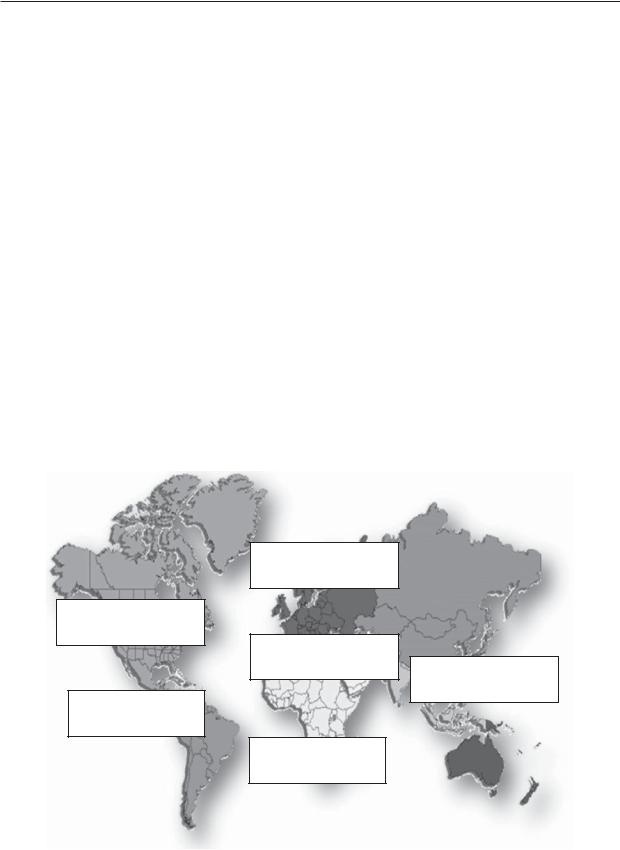
- •Table of contents
- •Abbreviations and Acronyms
- •Executive summary
- •Introduction
- •Institutional arrangements for tax administration
- •Key points
- •Introduction
- •The revenue body as an institution
- •The extent of revenue body autonomy
- •Scope of responsibilities of the revenue body
- •Special governance arrangements
- •Special institutional arrangements for dealing with taxpayers’ complaints
- •Bibliography
- •The organisation of revenue bodies
- •Getting organised to collect taxes
- •Office networks for tax administration
- •Large taxpayer operations
- •Managing the tax affairs of high net worth individuals taxpayers
- •Bibliography
- •Selected aspects of strategic management
- •Key points and observations
- •Managing for improved performance
- •Reporting revenue body performance
- •Summary observations
- •Managing and improving taxpayers’ compliance
- •Bibliography
- •Human resource management and tax administration
- •Key points
- •Aspects of HRM Strategy
- •Changes in policy in aspects of HRM within revenue bodies
- •Staff metrics: Staff numbers and attrition, age profiles and qualifications
- •Resources of national revenue bodies
- •Key points and observations
- •The resources of national revenue bodies
- •Impacts of recent Government decisions on revenue bodies’ budgets
- •Overall tax administration expenditure
- •Measures of relative costs of administration
- •International comparisons of administrative expenditure and staffing
- •Bibliography
- •Operational performance of revenue bodies
- •Key points and observations
- •Tax revenue collections
- •Refunds of taxes
- •Taxpayer service delivery
- •Are you being served? Revenue bodies’ use of service delivery standards
- •Tax verification activities
- •Tax disputes
- •Tax debts and their collection
- •Bibliography
- •The use of electronic services in tax administration
- •Key points
- •Provision and use of modern electronic services
- •Bibliography
- •Tax administration and tax intermediaries
- •Introduction
- •The population and work volumes of tax intermediaries
- •Regulation of tax intermediaries
- •The services and support provided to tax intermediaries
- •Bibliography
- •Legislated administrative frameworks for tax administration
- •Key findings and observations
- •Introduction
- •Taxpayers’ rights and charters
- •Access to tax rulings
- •Taxpayer registration
- •Collection and assessment of taxes
- •Administrative review
- •Enforced collection of unpaid taxes
- •Information and access powers
- •Tax offences (including policies for voluntary disclosures)
- •Bibliography

2. THE ORGANISATION OF REVENUE BODIES – 89
An increasing emphasis on the use of co-operative compliance strategies (e.g. Netherlands Horizontal Monitoring programme, Spain’s Code of Good Tax Practice, and the USA’s Compliance Assurance Process).
As will be evident from the data in Table 6.12 of Chapter 6, verification checks constitute a major element of the work of LTUs in many countries, generally resulting in a high degree of coverage for the taxpayers concerned and significant adjustments to assessments.
For CIS 2012, a number of revenue bodies reported on developments that affect the management of large taxpayers. The Canada Revenue Agency noted that in 2011 it decombined its income tax and GST/HST (VAT) compliance programmes to prioritise and strengthen its focus on GST/HST in conjunction with the implementation of provincial HST. The Czech Republic reported the establishment of a new specialised large taxpayer service, effective from January 2012. Portugal reported the creation of a new upgraded Large Taxpayer Division, effective from early 2012 as part of the newly integrated tax and customs administration. The United States Internal Revenue Service reported that it was beginning a process of reorganising parts of its Large Business and International Division into clearer geographical sections in order to improve its efficiency and reduce travel costs; the changes will allow the LB&I Division to keep its six industry groups, but the industries will be realigned so they have clearer boundaries of contiguous states. The realignment will be effective from October 2012, the start of the Service’s next fiscal year. In addition, in the 2011 fiscal year the IRS made organisational changes designed to realign its international functions into a single international unit within the Large Business and International Operating Division.
Managing the tax affairs of high net worth individuals taxpayers
High net worth individuals (HNWIs) is another segment of taxpayers that has drawn the attention of international organisations and a number of revenue bodies. The FTA’s 2009 report “Engaging with High Net Worth Individuals” drew attention to the challenges posed to revenue bodies from this segment of taxpayers.4 Its key findings were:
The HNWI segment consists of high wealth and high income individuals and is of particular interest for revenue bodies because of the 1) complexity of their affairs and the large numbers of entities they may control; 2) amounts of tax revenue at stake; 3) opportunity to undertake aggressive tax planning; and 4) impact on overall integrity of the tax system.
To improve compliance, revenue bodies could consider changing the structure of their operations to more effectively focus resources, for example, through the creation of a dedicated HNWI unit and to include a focus on the activities of HNWI-related activities.
Greater international co-operation, at both a strategic and an operational level, would improve the sharing of information and expertise between revenue bodies, particularly on cross-border changes.
Drawing on these conclusions, the study made a number of recommendations, including that revenue bodies could improve the compliance of HNWIs by:
Gaining a greater understanding of the risks posed by the HNWI segment by: 1) looking at the types of aggressive tax planning (ATP) schemes in the marketplace, the suppliers of ATP, and the HNWIs motivation; and 2) developing a strong commercial awareness of the broader concerns of HNWIs, including privacy, wealth preservation and their ability to pass wealth to future generations.
TAX ADMINISTRATION 2013: COMPARATIVE INFORMATION ON OECD AND OTHER ADVANCED AND EMERGING ECONOMIES – © OECD 2013

90 – 2. THE ORGANISATION OF REVENUE BODIES
Building an effective capability to manage tax risks by establishing an appropriate structure in revenue bodies to deal with HNWIs and focusing resources by: 1) creating dedicated units which are adequately staffed by experienced officials; and 2) establishing a framework for dialogue between senior revenue officials, HNWIs and their advisers.
Improving international co-operation, including the use of regular meetings between heads of HNWI units and other specialists within revenue bodies.
Creating an appropriate legislative framework targeted at specific aggressive tax planning risks by taking a holistic approach to focus their strategies.
Emerging trends in the growth and wealth of HNWIs
The FTA’s May 2009 report on HNWIs observed that this taxpayer segment should be of interest to revenue bodies given the complexity of their affairs and the tax revenue potentially at stake from any non-compliance. However, it did not attempt to quantify the possible scale of this risk or provide data on the likely population or wealth of HNWI taxpayers across member countries.
Box 2.5. The state of the world’s wealth: some recent research findings
Overall findings
After witnessing robust growth of 8.3% in 2010 and 17.1% in 2009, the global HNWIs population grew marginally by 0.8% in 2011.
HNWIs’ aggregate investable wealth, as measured by asset values, declined by 1.7% to USD 42 trillion, amid high volatility in global markets and challenging macroeconomic conditions.
The global population of ultra-HNWIs declined by 2.5% to around 100 000 in 2011, and their wealth declined by 4.9%, after gaining 11.5% in 2010.
Key findings by region
The number of HNWIs in Asia-Pacific expanded 1.6% to 3.37 million in 2011, making Asia-Pacific the largest HNWI region for the first time, surpassing North America’s HNWI population of 3.35 million; however, growth in the region was constrained by significant declines in the numbers and wealth of HNWIs in both India (down 18.0%) and Hong Kong (down 17.6%).
North America remained the largest region for HNWI wealth at USD 11.4 trillion compared to USD 10.7 trillion in the Asia-Pacific region. Growth in all regions is depicted in Figure 2.13.
Various pockets of growth emerged in HNWIs ranks beyond Asia-Pacific; for example, the HNWI population grew by 2.6% in Brazil where gross national income, national savings, real estate and other metrics were all positive, Thailand also saw large growth (by 12.8%).
While growth in wealth was down in Europe, the number of HNWIs rose by 1.1%, due largely to the growing number of HNWIs in Russia, the Netherlands and Switzerland.
Key findings by country (estimated numbers of HNWIs and movement over prior year)
USA: 3.068 million (down 1.2%)Japan: 1.822 million (up 4.8%)
Germany: 0.951 million (up 3.0%)China: 0.562 million (up 5.2%)
UK: 0.441 million (down 2.9%)France: 0.404 million (up 1.9%)
Canada: 0.280 million (down 0.9%)Switzerland: 0.252 million (up 3.6%)Australia: 0.180 million (down 6.9%)Italy: 0.168 million (down 1.3%)
Brazil: 0.165 million (up 6.2%)
South Korea: 0.144 million (down 1.5%)
Source: World Wealth Report 2012, by Capgemini and RBC Wealth Management.
TAX ADMINISTRATION 2013: COMPARATIVE INFORMATION ON OECD AND OTHER ADVANCED AND EMERGING ECONOMIES – © OECD 2013

2. THE ORGANISATION OF REVENUE BODIES – 91
For CIS 2010, in addition to seeking details of developments by participating revenue bodies, a short review was carried out of research conducted by wealth management specialists of trends in the growth and associated wealth of HNWIs between 2008 and 2009. The review found, somewhat surprisingly coming in the aftermath of the global financial crisis, that the world’s population of HNWIs (as defined by the researchers) grew some 17.1% to around 10 million in 2009 and their wealth by an equally remarkable 18.9% to USD 39 trillion. Similarly, after losing 24% in 2008, ultra-HNWIs (as defined by the researchers and numbering some 93 100 in 2009) saw their wealth rebound by 21.5% in 2009.
For CIS 2013, similar research sources have been used to gauge trends over the following two years and the key findings are set out in Box 2.5 and Figure 2.13.5 Significantly, these findings (Capgemini, 2010) point to a significant slowing in overall wealth growth and related numbers of HNWIs, although some significant changes in growth patterns at a regional level are highlighted.
Other research findings (Crédit Suisse, 2011) provide additional perspectives on the population of HNWIs, although using different classifying criteria and sources of information.
Taken as a whole, the findings of the abovementioned research, assuming their general accuracy, lend support to the findings of the FTA’s 2009 study and the need for revenue bodies to be especially vigilant in respect of this segment of taxpayers.
Figure 2.13. High net worth individuals – Estimated numbers and wealth in 2011
(and movements since 2010)
North America
No. HNWI: 3.35 m (-1.1%) Wealth: USD 11.4 tn (-2.3%)
Latin America
No. HNWI: 0.5 m (+5.4%) Wealth: USD 7.1 tn (-2.9%)
Europe
No. HNWI: 3.2 m (+1.1%) Wealth: USD 10.1 tn (-1.1%)
Middle East
No. HNWI: 0.5 m (+2.7%) Wealth: USD 1.71 tn (+0.7%)
Africa
No. HNWI: 0.1 m (+3.9%) Wealth: USD 1.1 tn (-2.0%)
Asia-Pacific
No. HNWI: 3.37 m (+1.6%) Wealth: USD 10.7 tn (-1.1%)
Sources: Capgemini and RBC Wealth Management: World Wealth Report 2012.
TAX ADMINISTRATION 2013: COMPARATIVE INFORMATION ON OECD AND OTHER ADVANCED AND EMERGING ECONOMIES – © OECD 2013

92 – 2. THE ORGANISATION OF REVENUE BODIES
Dedicated HNWI organisational units and their staff resources
In recommending that revenue bodies set up dedicated organisational units where this was not already the case, the FTA’s study made a number of observations as to the rationale for such arrangements, that are re-iterated below (from page 42 of the study report).
It is important that tax administrations have regular and continued interaction with the HNWI segment and their advisers on issues such as planning, compliance and service. This can increase the tax administration’s understanding of not only specific taxpayers but also its broader understanding of the HNWI population. It will also help the HNWI segment and their advisers gain an understanding of the tax administration. A tax administration will most effectively gather information on the HNWI segment where it tasks certain parts of its organisation with doing so.
The way in which resources are focussed on the HNWI segment can take a number of forms. The most prevalent is that of a dedicated unit. Advisers clearly stated in the consultation process that this was also their preferred method of dealing with the tax administration in relation to their HNWI clients. Such a unit will typically take responsibility for those taxes that have a direct impact on the HNWI’s personal tax liabilities. In some countries the coverage extends further to dealing with associated investment and business entities such as trusts, controlled investment companies and other operating entities, and the unit may also take responsibility for family members to enable the administration to take a wider view of the HNWI.
A dedicated unit is not a goal in itself but is a delivery vehicle that serves several functions: it sends a clear message to the non-compliant HNWI that he or she faces a real risk of being pursued by the tax administration which may in turn reduce aggressive behaviour and improve voluntary compliance; it enables a tax administration to match the level of expertise and knowledge of the HNWI’s advisers in addition to developing the commercial awareness of tax administration staff; and it also allows for the concentration of skills, targeted training, the retention of knowledge and thus an improvement over time of the understanding of the HNWI population. A dedicated unit can be monitored, and further improved, more easily than when resources are spread.
The approaches of revenue bodies in 2012
For the purpose of this series participating countries were surveyed on whether any special steps had been taken to create dedicated HNWI units, what resources were being devoted to the administration of HNWI taxpayers, the criteria used to identify HNWIs and related entities and the numbers of HNWIs being administered, and the results of related verification activities.
Information concerning the operation of dedicated units to administer HNWIs, as viewed from the CIS 2012 survey, is set out in Table 2.7. The key observations and findings are:
Relatively few revenue bodies have established dedicated units to oversee HNWIs;
A number of revenue bodies reported other organisational arrangements or developments for HNWIs-France reported that while it does not have a specific service to manage HNWI’s situations, there is a dedicated directorate responsible for the control (i.e. audit) of the wealthiest taxpayers (as defined in Table 2.7); the US IRS reported that its Large Business and International (LB&I) operating
TAX ADMINISTRATION 2013: COMPARATIVE INFORMATION ON OECD AND OTHER ADVANCED AND EMERGING ECONOMIES – © OECD 2013

2. THE ORGANISATION OF REVENUE BODIES – 93
division created a Global Wealth Unit in November 2009 which it will use to focus compliance expertise on high-wealth individuals and the enterprises they control (once identifying criteria are settled and operationalised); and Spain reported that it administers special arrangements for designated HNWI’s taxpayers through its large taxpayer unit;
The scale of these units varies significantly in terms of the numbers of HNWIs administered and the resources used, suggesting differences in the roles/functionscarried out by the respective units.
Given the indications of growth in recent years in the numbers and wealthy individuals referenced in Box 2.5 and the relatively small number of revenue bodies reporting they have dedicated units to deal with such taxpayers (however defined at the individual country level), there would seem a case for many revenue bodies to consider whether they have the appropriate organisational and management arrangements in place to ensure that this segment of taxpayers receives the appropriate level of scrutiny to detect and deter non-compliance.
Table 2.7. High net worth individuals: criteria, taxpayer numbers and staffing
(For revenue bodies with dedicated units for their high net worth individuals)
|
|
Number of |
Staff in 2011 |
|
Criteria applied to identify HNWIs |
taxpayers |
(FTEs) |
OECD countries |
|
|
|
Australia |
Residents (and any associates) who effectively control over AUD 30 m in net wealth |
2 628 |
243/1 |
Canada |
Individuals who, either alone or with related parties, control net worth over CAD 50 m |
550-600 (E) |
/1 |
|
grouped in 30 or more entities |
|
|
France/1 |
Two categories: Regular HNWIs and Top HNWIs using asset, income etc criteria/1 |
4 300/1 |
269 |
Hungary |
/1 |
- |
- |
Ireland |
Individuals with assets > EUR 50 m and non-residents with substantial economic interests in |
1 066 |
18 |
|
Ireland |
|
|
Japan |
(Confidential) |
226 |
76 |
New Zealand |
Assets over USD 50 m (most have over 30 entities associated with them) |
177 |
9 |
Spain/1 |
Income > EUR 1 m or personal assets > EUR 10 m, or individuals/partners related to other |
244 |
/1 |
|
large taxpayers or who manage complex economic transactions |
|
|
United Kingdom |
Assets over GDP 20 m |
5 400 |
370 |
United States |
(Under development)/1 |
(Tbd) |
94 |
|
|
|
|
Non-OECD countries |
|
|
|
Argentina |
Mix of tax assessed, tax paid, annual sales, VAT debt, economic sector and no. of |
1 164 |
497 |
|
employees |
|
(i.e.LTU) |
Brazil |
Not disclosed but identification based on studies focusing on income, assets |
5 000 |
/1 |
Lithuania |
/1 |
|
|
Malaysia |
Individuals with statutory income over MYR 1 m, assets over MYR 5 m or both together over |
4 272 |
152/1 |
|
MYR 5 m |
|
|
Romania |
Wealth (as per open sources), declared income over threshold and estimates of assets |
/1 |
25/1 |
|
held/1 |
|
|
South Africa |
Gross income >ZAR 7 m or unencumbered assets >ZAR 75 m, and connected individuals (I) |
468 (I) |
10 |
|
and entities (E) |
1 205 (E) |
|
Source: CIS survey responses.
For notes indicated by “/ (number)”, see Notes to Tables section at the end of the chapter, p. 101.
TAX ADMINISTRATION 2013: COMPARATIVE INFORMATION ON OECD AND OTHER ADVANCED AND EMERGING ECONOMIES – © OECD 2013

94 – 2. THE ORGANISATION OF REVENUE BODIES
Criteria being used to identify HNWIs and numbers of taxpayers administered
The FTA’s study noted that revenue bodies have limited resources to dedicate to this taxpayer segment. As a result, allocating and managing resources requires an understanding of the segment to establish the thresholds and other limits that can be used for identifying those individuals to be included in any focus on the HNWI population. For the countries studied, it was reported that a range of criteria is used to define the HNWI population for administrative purposes. These include income and/or wealth thresholds and criteria indicating complex tax affairs, such as a variety of income sources and international tax issues. Some countries pay particular attention to public company executives and directors or to wealthy individuals with high public profiles. Others are particularly concerned about “emerging” wealthy taxpayers, sometimes observed in the media. Generally there will be a combination of these factors together with others that a particular revenue body feels are relevant to its own situation.
Concerning the use of “wealth” as a key criterion, the FTA’s study report noted that its use may be feasible as a criterion even by countries that do not have a wealth tax. To acquire wealth an individual generally requires substantial income, whether taxed or not. In addition, wealth as an indicator tends to be relatively stable whereas income can vary substantially from year to year and, as a measure, can also be affected by tax planning. Consequently, a definition of the HNWI population based on income alone may be problematic. Relevant data on accumulated wealth can be derived from sources such as the tax return (which in some countries includes a statement of assets and liabilities), data held by other government departments (e.g. concerning real property and share holdings, information returns made by financial institutions, and media reports, etc.
As indicated in Table 2.7, the criteria used by revenue bodies with dedicated HNWI units (albeit, from a small number of revenue bodies) tend to focus primarily on estimated wealth/asset levels of the taxpayers concerned.
Examples: The risks presented by HNWI taxpayers and the approaches being adopted
The examples provided in Boxes 2.6 and 2.7, extracted from the published compliance programmes of the revenue bodies indicated, provide some insight as to their concerns in relation to the nature and scale of risks presented by their respective HNWI segments and what actions they propose to take to deal with potential compliance issues.
TAX ADMINISTRATION 2013: COMPARATIVE INFORMATION ON OECD AND OTHER ADVANCED AND EMERGING ECONOMIES – © OECD 2013

2. THE ORGANISATION OF REVENUE BODIES – 95
Box 2.6. South Africa: SARS compliance focus on wealthy individuals and their trusts
Understanding HWI
SARS has around 2 300 wealthy individuals on register. This group of taxpayers is a significant contributor to the fiscus, with wealthy individuals contributing an average of ZAR 1.7 million each to tax annually.
Key concerns
SARS’s preliminary sampling exercise has shown that under-declaration of income is an area of concern, where an individual’s declared income is not consistent with their asset base. To date, 467 potential wealthy individuals have been identified where there are discrepancies between their asset base and declared income, and they can expect much closer scrutiny from SARS. Wealthy individuals are also generally linked to a number of trusts and companies, some of which are used as vehicles to channel and hide their assets and income. Most of the wealthy South Africans we have reviewed are linked to more than 10 associated companies on average and 87% of these associated companies and 59% of trusts have outstanding returns. A total of 67% of audits conducted into trusts show serious under-reporting. Among the issues which are cause for concern are:
Fringe benefits not being declared;
Input VAT claimed without declaring VAT on trade income;Artificial losses and deductions;
Assets and income diverted through associated entities; andSalary restructuring;
Incorrect declaration of revenue profit as capital in nature.
SARS’s approach to compliance
Compliance activities for this segment includes a range of initiatives:
Increase the use of data flows from other jurisdictions through the international Exchange of Information programme;
Improving our collaboration with the Master’s Office with regard to administration of trusts, specifically in terms of obtaining information electronically and uniformly as well as acquiring complete information on trustees and beneficiaries;
Reviewing how best to leverage “industry” norms and benchmarks, and improving our ability to trace the flow of funds around the world through a multi-agency approach;
Moving towards more pre-emptive engagement with taxpayers based on real-time data, and the use of pre-filing meetings;
Improving our rulings regime, and encouraging more taxpayers to make use of advance rulings;
Broaden our audit and investigations to include additional third party information including the lifestyle and related entities questionnaire;
Ensuring the registration of wealthy individuals currently not on register
Audit will focus on those individuals identified as having discrepancies between their asset base and declared income;
Reviewing the structure of tax returns for both wealthy individuals and trusts;
Encouraging taxpayers to make voluntary disclosures – and making known to them the consequences if they do not.
Source: Extract from SARS Compliance Programme: 2012/13-2016/17.
TAX ADMINISTRATION 2013: COMPARATIVE INFORMATION ON OECD AND OTHER ADVANCED AND EMERGING ECONOMIES – © OECD 2013

96 – 2. THE ORGANISATION OF REVENUE BODIES
Box 2.7. Australia: Reported approaches/experiences for highly wealthy individuals
Understanding HWI
Australia’s wealthiest individuals often have complex business structures which can create opportunities for sophisticated tax planning. The ATO utilises innovative data matching and risk modelling to support its comprehensive understanding of the relationships, arrangements and tax risks within these business structures. These models help it develop tailored compliance strategies based on each taxpayer’s specific risk categorisation. As of end-2011, over 2 600 HWI taxpayers were under the administration of its HWI unit.
Key concerns
The ATO identifies tax risks associated with significant restructures and events including mergers, acquisitions, initial public offerings, asset sales and generational change. Key concerns include:
lifestyles funded without relying on income in a conventional taxable form;use of business assets for private purposes;
classifications of income and expenses between capital and revenue accounts;capital gains tax not returned or inappropriately minimised;
accessing company profits other than via dividends; and
concealment of overseas interests and international dealings.
Identifying/monitoring HWI taxpayers
The ATO has invested significantly in data acquisition and system development. Its systems have become increasingly effective in identifying and monitoring HWI and their groups. It now actively monitors over 2 600 HWI. Information sources include:
Tax returns and activity statements
Expanded returns and Private Group Structure questionnairesAUSTRAC (e.g. large cash dealings)
Australian Securities and Investments CommissionLand title, motor vehicle and share registries
Investment, interest and dividend data
Intelligence and referrals from overseas tax agencies.
Impacts – correct reporting
While acknowledging HWI’s sensitivity to the economic cycle, the ATO’s increased compliance activity since 2006 appears to be having a positive impact on correct reporting. For example, improvements have been seen in the effective tax rates of HWI and their associated beneficiaries compared to other individuals. Where HWI have been subject to an income tax review or audit, the ATO measures their tax performance for three years following its compliance interventions. The ATO estimates that since 2006 over USD 200 million of additional income tax has been voluntarily paid in the years following the completion of audits. Further, 16 HWI reported offshore income / assets leading to USD 9.9 million in liabilities.
Source: ATO Compliance Program 2012-13.
TAX ADMINISTRATION 2013: COMPARATIVE INFORMATION ON OECD AND OTHER ADVANCED AND EMERGING ECONOMIES – © OECD 2013

2. THE ORGANISATION OF REVENUE BODIES – 97
Notes
1.The “Zakat” is a levy applied at a flat rate of 2.5% on the net worth (not net income) of Saudi natural persons, wholly Saudi owned companies, and Saudi partners in joint ventures (except for rain-fed agricultural products and irrigated agricultural products for which the rate is 10% and 5% respectively).
2.For CIS purposes, a reasonably broad definition is taken of what constitutes “headquarters functions”; that is, it includes all functions that support national planning and operations, including the national executive and programme policy development and management, as well as all support functions such as information technology operations, human resource management, public relations, security, finance, and internal audit.
3.The comments provided draw largely on survey responses and separate work carried out by a FTA’s Task Group (involving Australia, Canada, France, Ireland, Netherlands, Norway, UK, and USA) set up in 2007 to explore and share experiences and latest thinking on the approaches and practices for dealing with the tax compliance issues of large businesses. For more detailed information see Compliance Management of Large Business: Experience and Practice in Eight OECD Countries (OECD, 2008).
4.Both the FTA report and this series use the term “High Net Worth Individuals” (HNWIs) to refer to individuals at the top of the wealth or income scale. The term is used broadly and thus includes both high wealth and high income individuals. However, it is recognised that there are segments within this broad definition that display different characteristics and may, therefore, require different administrative responses from revenue bodies.
5.For their purposes, the authors use a proprietary methodology which defines HNWIs as those individuals having investable assets of USD 1 million or more. For “ultra-HNWIs”, the investable assets criterion is set at USD 30 million. Details of the methodology are elaborated in the report.
Notes to Tables
Table 2.1. Selected features of the organisational structure of revenue bodies
/1. Australia: Mainframe, network and communications hardware and support are outsourced; Austria: IT functions provided by the MOF or similar department; Canada: Dedicated large taxpayer compliance programme; Chile: The revenue body (SII) perform only the initial effort to collect tax debts, with primary responsibility for enforced debt collection resting with the Treasury (TGR); Cyprus: VAT Department has a large taxpayer division; Denmark, Finland, Slovak Rep., United Kingdom: IT operations are largely outsourced; France: The French tax administration doesn’t have a specific service to manage HNWIs. It is done by local services. Nevertheless, a dedicated directorate (DNVSF) is responsible for the control of the wealthiest individuals, as defined (see Table describing criteria for HNWI’s); Germany: Most states have tax office for large taxpayer audits and tax fraud function, specialised debt collection units, appeals units, and full in-house IT functions; Greece: Large taxpayer audit functions; Hungary: However NTCA does not have a specified unit for out of court settlements or for consultation with taxpayers. Iceland: Debt collection is handled by Customs; Ireland: While Revenue do not have a dedicated unit in charge of appeals disputes, it does have an appeals function. Customers may lodge complaints at their local office, submit their case for an internal or external review and/or make an appeal under statutory provisions (via the Appeals Commissioners, Ombudsman’s Office or the Equality Tribunal); Italy: Debt collection outsourced to separate company (Equitalia spa). Japan: Special units are located at regional level to examine international taxation issues of HNWIs and small/medium enterprises; Korea: Large taxpayer unit at regional level only;
TAX ADMINISTRATION 2013: COMPARATIVE INFORMATION ON OECD AND OTHER ADVANCED AND EMERGING ECONOMIES – © OECD 2013

98 – 2. THE ORGANISATION OF REVENUE BODIES
Lithuania: Revenue body has a separate IT department which provides all internal services and system support but systems development is done by external companies; Malaysia: Special Units at branches set up in December 2010 to handle tax cases related to High Net Worth Individuals and VIP/Staff. Mexico: A dedicated organisational unit responsible for IT functions but with substantial outsourcing of its operations; Netherlands: * At regional tax offices, no separate HNWI-units but a coordinated approach is taken as an integral part in the horizontal monitoring programme. * From 2013, tax districts will be organised according to taxpayer segments in addition to the functional approach; Portugal: From 2012 onwards. Romania: Mainly organised based on the functional criterion, but also use also the “taxpayer segment” criterion with specialised structures within the tax administration to administer large taxpayers (one large taxpayers department) and middle-sized taxpayers (42 county units for middle-sized taxpayers); Singapore: There are separate large taxpayer departments for Corporate Tax and Goods and Services Tax; Slovak Rep.: Some tax offices have departments for auditing large taxpayers (HMWIs); There is a department for audit techniques for large taxpayers established at the Tax Directorate of the SR Tax Office for Large Taxpayers Bratislava – manages banks, branches of non-resident banks, insurance agencies, branches of non-resident insurance agencies, reinsurance agencies and branches of non-resident reinsurance agencies, taxpayers with a turnover>EUR 33.2 milion; Spain: HNWI taxpayers can be assigned to the Spanish Large Taxpayers Central Office under certain circumstances by the Head of the Service for Planning and Institutional Relations; other wealthy taxpayers are managed by provincial or, where appropriate, regional offices; Sweden: Enforcement of the collection of public and private debt is carried out by a separate Enforcement Agency, previously part of the Swedish Tax Agency but fully independent from January 2008. Separate units for tax fraud, but not for tax evasion cases; Switzerland: For large taxpayers a personal contact person in the field of VAT is projected for 2012. United States: Establishment of HNWI unit in course of development.
/2. Canada: In 2011, the Federal Government created Shared Services Canada (SSC) “to streamline and consolidate government networks, data centres, and email systems, and to get better services and value for money. SSC brings together resources from the 43 organisations that SSC serves, including some 750 FTEs from the CRA. Chile: Only relates to tax return and sworn statement processing. Cyprus: It has been many years that criminal prosecutions have not been carried out by Direct Tax Department; Greece: There is no permanent organisational unit responsible for HWI. A special team focusing on HWI operated during 2009
– 2011. In late 2011 the functions of this team were transferred to the Directorate of Audits and HWI are now audited by special audit teams. Iceland: The Directorate of Internal Revenue (DIR) has a special Tax Control Division that is responsible for tax control/tax audits; the Directorate of Tax Investigations is responsible for all tax investigations (criminal tax matters). Italy: The Central Directorate of Tax Assessment performs operational tasks in fiscal control activities of particular relevance. Within it there is a Central Anti-fraud Unit dealing with: 1) analysis of widespread fraud in the tax and development of law enforcement strategies and the resulting operational methods; 2) coordination and monitoring of control activities linked to widespread fraud and conducted in the territory; and 3) conducting investigations and audits at national level on the phenomena of fraud of greater importance and danger; however, the Financial Guard (Guardia di Finanza) by virtue of its primary role of economic and financial police plays the central role in dealing with serious criminal tax evasion cases, under direction of Prosecutor Offices. Latvia: IT operations are partly outsourced; Korea: Debt collection unit at regional level for all taxpayers including large taxpayers only; Netherlands: Large Business Taxpayers Units in Regional Tax Offices; Spain: The Tax Appeals Courts (central and regional level) are part of the Ministry of Finance and Public Administration, independent of the Tax Agency; Switzerland: The organisational unit for debt collection is projected for 2013.
/3. Greece: There is a committee which is competent for resolving tax disputes exceeding certain amounts of taxes, duties, contributions or fines. Iceland: A large portion of IT operations are outsourced; Italy: IT functions provided by the MOF or similar department; Netherlands: separate dedicated units for each function of debt collection and disputes in regions.
Table 2.3. Office network for tax administration-numbers by office type (end-2011)
/1. Australia: But co-located with branch and regional sites. Cyprus, Luxembourg: There are separate departments/offices at all levels for direct and indirect taxes; France: Structures dedicated to individuals, SMEs, land registry, and property registration. Germany: There are 16 decentralised Lander administrations and one national co-ordinating organisation; Greece: Regional level: these are 2 Inter-regional Audit Centres and 6 Regional Audit centres; local level: these are 239 local tax offices and 100 local customs offices; other: this is the Special Secretary of the Financial and Economic Crime unit with central and regional services. Ireland: Headquarters comprises the Board of the Revenue Commissioners, Corporate Services Division, Planning Division and ICT&L Division; regional offices comprise four regional entities and the Large Cases Division, Collector Generals Division and the Investigations and Prosecutions Division, all headed by an Assistant Secretary reporting to the Board; other offices include 3 Revenue Legislation Service Divisions and the Revenue Solicitors Office; Malta: Taxes are administered by three separate departments, that
TAX ADMINISTRATION 2013: COMPARATIVE INFORMATION ON OECD AND OTHER ADVANCED AND EMERGING ECONOMIES – © OECD 2013

2. THE ORGANISATION OF REVENUE BODIES – 99
are planned to be integrated into one organisation over the next 2 to 3 years; Malaysia: Comprised of 36 assessment branches, 17 investigation branches and 14 revenue service centres; Mexico: These are customs offices; Netherlands: Headquarters is the Directorate General; regional tax districts are led by a dedicated head office and Centres for ICT, Facilities and Professional Education and Communication are labelled under “other offices”. Poland: Numbers of staff include Fiscal Audit Offices. Norway: There is an office reduction project underway; at the beginning of 2011, there were 225 offices and 175 at year-end, giving an average in 2011 of around 200; it is expected the number will be around 110 by January 2013; South Africa: Data includes customs operations; Spain: There are 17 regional offices and 51 provincial offices; in addition to the 202 local tax offices there are 36 customs and excise local offices.
/2. Australia: With a further 6 co-located with local, branch or regional branch offices.
Table 2.4. Office network for tax administration-number of staff by office type (end-2011)
/1. Argentina: Staffing aggregates shown include customs administration staff. Australia: Figures represent average staffing (FTE) over the 2010-11 financial year. Cyprus and Luxembourg: Staff usage figures cover both direct and indirect taxes, administered separately. Germany: Call centre staff FTEs included in local office aggregates; Hungary: Aggregate data includes Customs operations; data for call centres are also included in aggregates for headquarters and regional offices where they are located; data for other offices include Training etc Institute (369) and Directorate of Criminal Affairs (357). Ireland: Headquarters is comprised of the Board of the Revenue Commissioners, Corporate Services Division, and Planning Division (251 FTEs in total) and the ICT&L Division (412 FTEs). Israel: Staff aggregates include Customs; Japan: The number of staff at regional offices includes staff in processing centres and call centres; Lithuania: These aggregates are included in HQ aggregate. Mexico: National processing and call centre operations are outsourced, numbers shown are SAT’s supervisors; in addition to aggregate staff number shown, there are 7 548 staff located in 49 customs offices. Netherlands: These figures include staff at the head office of tax regions and a rough estimate of staff at the Directorate General for Tax and Customs Administration and at the Centres for ICT, Professional Education and Facilities, the latter three not defined as headquarters in the Netherlands. Poland: Numbers of staff include Fiscal Audit Offices. Singapore: Staff strength at end March 2011. South Africa: Data aggregates include customs operations; other offices FTEs are principally customs operations. Spain: Other offices included in headquarters data. Sweden: Staff FTEs of one call centre in regional office data. United Kingdom: In addition to staff in the table categories, there is an additional 258 FTE in non office accommodation (stores/garages). United States: The IRS advised that it defines “headquarters” as the office within the IRS that is responsible for providing core leadership, developing short and long-term strategic plans, providing guidance on the implementation of programmes and monitoring of the execution of approved policies and plans. The Data Processing Centre is not directly involved in these functions and therefore it is not included in “headquarters”; the change in headquarters and regional office data from prior editions of CIS is primarily the result of changes to the current IRS structure and how the organisation’s operations are managed; the regional office component includes the IRS’s central computing centre and the large tax return submission centres.
Table 2.5. Large taxpayer operations: Criteria, numbers and staffing
/1. Belgium: A new large taxpayer organisation is being established that is expected to administer around 15 000 large taxpayers, and require around 495 staff when fully operational in 2014. Brazil: General criteria are gross revenue > RUSD 100 m, treasury debts > RUSD 10 m, payroll > RUSD 18 m, or social security debts > RUSD 6 m; limited data available on staffing for 2009 when some 146 FTE were employed full time with assistance from a further 358 persons; an additional three units (one for HNWIs) have recently been created, one in Sao Paulo (devoted to auditing activities), another in Rio de Janeiro provides a full range of services to large entities and the other in Belo Horizonte (for HNWIs); Bulgaria: Main criteria are: 1) Taxable persons meeting at least two of the following criteria: a) sales in 2009 of over BGN 20 m; b) over 120 persons on average in 2009; c) taxes and SSCs paid in 2009 of over BGN 2 m; d) taxes refunded in 2009 of over BGN 2 m; 2) Companies in the industries of banking, insurance, reinsurance, pension and health insurance. Canada: The first category refers to income tax; the target population is large, complex corporations and their related entities, including trusts, partnerships and controlled subsidiaries; as of April 2008, the definition of “Large Business” was changed to include any entity for which the large business team audit approach would be effective. As risk and complexity have become more important factors in determining whether or not to treat the entity as being part of the large business population, files under the USD 250 million threshold that meet these new criteria could be considered for inclusion in this population; The second category concerns the Goods and Services Tax/Harmonised Sales Tax and includes GST/HST registrants, excluding the Municipalities, Universities, Schools, and Hospitals (MUSH sector), with annual revenue in excess of USD 100 million; Companies controlled by those large registrants; and Complex non-resident registrants.; Chile: Annual turnover equal to or higher than 90 000 UTA, during each of the last three commercial years;
TAX ADMINISTRATION 2013: COMPARATIVE INFORMATION ON OECD AND OTHER ADVANCED AND EMERGING ECONOMIES – © OECD 2013

100 – 2. THE ORGANISATION OF REVENUE BODIES
taxable capital equal or higher than 110 000 UTA, during each of the last three tax years; and other criteria. NB: UTA=Unidad Tributaria Anual (Annual Tax Unit, equal to twelve times the Monthly Tax Unit of December, which is a unit indexed to inflation); China: The SAT advised that there is a dedicated Large Taxpayer Department (LTD) in SAT, but currently there is no national uniform standard/threshold for large taxpayers in China.; the LTD in the head office of SAT administers 45 large taxpayers, and their selection is based on a combination of industry, turnover and ownership; SAT offices at and below provincial levels set their own standards for large taxpayers, taking into consideration of the not-so-small gaps among the provinces with respect to the level of economic development; there are 21 people (FTE) in the Large Taxpayer Department in the head office of SAT, nationally speaking there are around 2 600 at SAT offices at different levels administering large businesses; Colombia: Number shown refers to taxpayers administered by Office of Large Taxpayers; regional offices also manage large taxpayers, bringing the total number to 7 167: Finland: Threshold of EUR 50 m applies to an individual company or group of companies; France: Companies which are related directly or indirectly by a link, ascending or descending at more than 50%, with a company that meets the turnover criterion. Germany: Most regional “Lander” administrations have a large taxpayer audit function; industry criteria applied are 1) manufacturing: turnover > EUR 4 m or profit > EUR 235 000; Freelancers: turnover > EUR 4.3 m or profit > EUR 540 000; Financial Institutions: actual net worth > EUR 128 m or profit > EUR 530 000, insurance companies: insurance premium revenues > EUR 28 m, agricultural and silvicultural companies: economic value on the basis of land> EUR 210 000 or profit > EUR 116 000; Other enterprises: Turnover > EUR 5.3 m or profit > EUR 305 000; Greece: new Large Taxpayer Division was created in late 2011. Hungary: The method for “tax capacity” is ruled by the decree of Ministry of National Economy; “tax capacity” shall mean the yearly average of a taxpayer’s gross tax liabilities on the aggregate (including budgetary subsidies, tax allowances and tax relief) within the term of limitation; it shall also include the amount of value added tax payable or the amount charged and deductible, whichever is greater in terms of absolute value. The calculation is based on the tax data available on 1st September in the previous fiscal year. In 2012, the limit for tax capacity is HUF 3 250 millions; India: All taxpayers assessed in five major cities who have paid excise of over Rs 50 million, service tax over Rs 50 million or advance corporations tax over Rs 100 million; Ireland: Criteria also includes semi-state commercial organisations; financial services sector; and relatively large scale enterprises in certain sectors; Korea: No dedicated national function for co-ordination but regional units manage tax resources and conduct audits for prescribed large taxpayers; Mexico: Also includes companies reporting consolidated results, foreign entities and state public entities, government oil companies and related entities, the social security agency; Netherlands: Criteria are 1) listed company at the (Amsterdam) stock exchange and/or 2) standard weighted fiscal worth exceeding 25 million euro and/or; 3) foreign parent and own standard weighted fiscal worth exceeding 12.5 million euro; and/or 4) at least 5 foreign subsidiaries and own standard weighted fiscal worth exceeding 12.5 million euro; and/or; 5) all non-profit organisations standard weighted fiscal worth exceeding 37.5 million euro; and/or 6) all companies in the financial industry (banks, insurance), the oil and gas industry (upstream and downstream) and in the energy-supply industry; and 7) other taxpayers not meeting the above factors, may be covered under the supervision concept for very large taxpayers if complex issues exist, or a taxpayer is viewed as potentially a high-profile case or with certain degree of financial risk; Norway: Other criteria that can apply include larger companies operating in multiple municipalities, with significant linkages to foreign countries, or as part of corporate groups, and shipping companies. Poland: Criteria are capital tax groups, banks, insurance establishments, units providing public trade of securities and provisions on investment funds, units operating as pension funds, branches or agencies of a foreign company, and companies that raised annual net revenue of at least 5 million in the previous year, participated directly or indirectly in the management of companies located abroad or control thereof or has a share in their capital, were managed directly or indirectly by a non-resident, or where a non-resident has a minimum of 5% of the votes at a meeting of shareholders or at a general meeting, and as a resident jointly participates directly or indirectly in the management of a domestic entity and foreign entity, or controls or has at the same time a share in the capital of such entities. Portugal: From January 2012, a new Large Taxpayer Office was created and commenced operations, as part of a major re-organisation of tax and customs operations; Romania: The base criteria, named “aggregated value criteria”, are derived from the aggregation of 4 indicators calculated for the prior 2 years, selected from an economic and budgetary point of view in the following proportions: 1) the volume of the owed fiscal obligations, declared by the taxpayer – 40%; 2) the volume of income from the operating activities – 30%; 3) the volume of expenditures for staff – 15%; 4) the volume of tangible and non tangible fixed assets; other criteria applied capture banking, insurance and other financial institutions, and newly established enterprises that have committed to make investments exceeding EUR 10 m; Saudi Arabia: Activities of economic significance: Oil, banks, stock companies, insurance, air-transportation, subsidiaries of international companies, and holding companies and their subsidiaries; Slovak Rep.: At the present time the Tax Office for Selected Taxpayers does not have state-wide scope, administering only large taxpayers in Bratislava and surroundings; the scope of the Tax Office for Selected Taxpayers will be extended to the whole territory from January 2013. South Africa: Major project carried out in 2009 to review operating
TAX ADMINISTRATION 2013: COMPARATIVE INFORMATION ON OECD AND OTHER ADVANCED AND EMERGING ECONOMIES – © OECD 2013

2. THE ORGANISATION OF REVENUE BODIES – 101
model of the Large Business Centre, resulted in revised criteria from October 2010; Spain: Criteria also includes those third party reporters providing over 10 000 records; United States: Includes corporations, foreign corporations, subchapter S corporations and partnerships with assets USD 10 million and greater.
/2. Australia: Around 1 300 economic groups encompassing 32 000 entities that file around 6 000 returns due to Australia’s consolidation rules; Canada: The Income Tax category includes 1 165 groups comprising 25 748 entities; Ireland: There are 11 211 companies (being part of 690 groups) and also 1 427 securitisation companies; Spain: Resources also include administration of designated large personal taxpayers/HNWIs; United States: The number reported is the number of returns filed in 2010 by Corporations (USD 10 m – USD 250 m)-46 002 returns; Corporations (over USD 250 m)-13 289 returns; Foreign Corporations (over USD 10 m)-2 831 returns; Partnerships (large business)-141 668 returns; and S Corps (USD 10 m and over)- 40 833 returns.
Table 2.7. High net worth individuals: criteria, numbers and staffing
/1. Australia: These staff are also supported by technical specialists, centres of expertise and Tax Counsel in active compliance activities which are not included in this number. Brazil: There is only one unit for HNWIs (largely devoted to auditing activities) and its resources are included in large taxpayer operations; Canada: Resources and results included in data for large taxpayers. Hungary: The decree dealing with large taxpayers, in addition to certain large companies, also categorises other taxpayers (including entrepreneurs, companies, and budgetary bodies) as “large” which have a tax capacity over HUF 140 m; these are subject to audit by special dedicated units in regional offices. France: The tax administration does not have a specific service to manage HNWI taxpayers’ situation – it is done by local services. Its HNWI Unit called DNVSF (National Directorate of Fiscal Situation Audits) is exclusively dedicated to audits and shared between regular HNWIs’ and “Top HNWIs”. The criteria described hereunder concern the control of the wealthiest individuals, which is done by a dedicated directorate (DNVSF) and dedicated local audit services. Objective criteria for “Regular HNWIs”: Taxpayers with total income (before allocation of deficits) over EUR 762 000, gross value assets over EUR 6 900 000; Members of non-commercial professions, whatever their legal form, with a pre-tax income of more than EUR 1 220 000. Subjective criteria: taxpayers whose national or international reputation is proven, either by professional or elective position or for any other reason; Taxpayers claiming residents of another country whose domicile is established, when the gross value of assets known in France is over than EUR 1 million. Complexity of situations: 1) the taxpayer’s situation comes under at least two international conventions signed by France; 2) known or suspected activities are diversified in the national territory or abroad and require dispersed investigation; and 3) known or suspected activities are diversified and are the subject of a judicial proceeding. Criteria for “Top HNWIs” Since 2011, DNVSF gets a new competence on taxpayers called “top HNWIs” whose gross income is over EUR 2 millions or whose gross income is below EUR 2 millions but whose assets liable to wealth tax is over EUR 15 million. It represents around 4 300 taxpayers whose situation regarding tax is examined every 3 years by DNVSF. This latter can carry out firstly a desk audit and, if necessary, a field audit. Lithuania: While there is no formal organisational unit as such, in 2011 a working group was established which analysed selected individuals’ wealth and income data according to various selection criteria, in order to determine risks related to possible tax evasion common for these individuals and determine the attributes to identify threats that could be applied while performing the monitoring of HNWIs’ tax obligations and selection for control actions. The working group evaluated the value of person’s real estate objects, capital of controllable units they manage, loan sums they have given (overdue) to legal persons, etc. and selected a number of risky HNWIs for examination; in 2012, control actions of selected risky HNWIs commenced. Netherlands: There are no separate HNWI units but at regional tax offices there is a coordinated approach designed as part of the compliance risk management strategy; the principles of horizontal monitoring (as developed along the lines of the 2009 OECD Study Engagement with High Net Worth Individuals) are applied as much as possible; Malaysia: The unit also administers VIPs tax affairs; Romania: This is a new development in Romanian tax administration, resulting from NAFA’s recent implementation of a compliance risk management approach; concerning the HNWI population, a special unit has been created, responsible for this tax compliance risk management process, which evaluates and applies the correct treatment for each HNWI associated risk identified, from notices and assistance all the way to the traditional treatment such as a tax audit; presently, the unit numbers 25 staff, managers included, with an option of a final staff number set at 50, as the activity is developed; Spain: Designated HNWIs are administered from within the Large Corporate Taxpayers Division; staff FTEs included in data for Large Corporate Division taxpayers; United States: The LB&I operating division created a Global High Wealth (GHW) unit in November 2009. Through the GHW unit, the IRS focuses compliance expertise on high income/high wealth individuals and the enterprises they control. The IRS is in the process of developing a model to define and profile high wealth taxpayers. (Note that the majority of IRS data and definition is focused on taxpayer income rather than overall wealth, since the U.S. does not tax wealth.)
TAX ADMINISTRATION 2013: COMPARATIVE INFORMATION ON OECD AND OTHER ADVANCED AND EMERGING ECONOMIES – © OECD 2013
